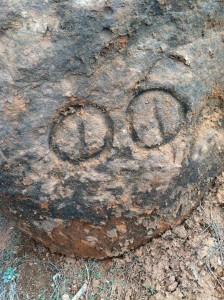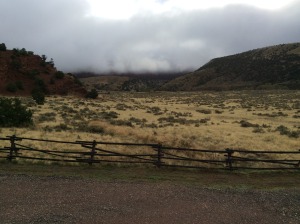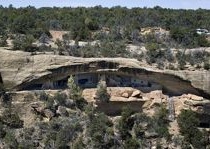Prehistoric petroglyph of buffalo hoof prints
- Thursday, 19 March 2015 21:26
 At first glance this prehistoric petroglyph, rock carving, might look like eyes. When you get close, however, you can tell that it’s actually buffalo hoof prints. Above the prints are four carefully ground dots. You can see two in this photo. These are found about a five minute walk from our front door in a box canyon. What do they mean? Well, we wish we knew. We suspect they are from the Late Prehistoric Period, which means made within the last 1,000 years. Interestingly, this is the one side canyon on the ranch where prehistoric peoples could have trapped buffalo. Is that what the petroglyph documents? “We trapped buffalo in this canyon four times.” No one will ever know, but the petroglyph is a constant reminder that buffalo have been here a long time, and native peoples used them to feed their families.
At first glance this prehistoric petroglyph, rock carving, might look like eyes. When you get close, however, you can tell that it’s actually buffalo hoof prints. Above the prints are four carefully ground dots. You can see two in this photo. These are found about a five minute walk from our front door in a box canyon. What do they mean? Well, we wish we knew. We suspect they are from the Late Prehistoric Period, which means made within the last 1,000 years. Interestingly, this is the one side canyon on the ranch where prehistoric peoples could have trapped buffalo. Is that what the petroglyph documents? “We trapped buffalo in this canyon four times.” No one will ever know, but the petroglyph is a constant reminder that buffalo have been here a long time, and native peoples used them to feed their families.
Thanks to Mike and Annie Blakely for taking this great shot. Ours aren’t nearly as good!
Free Excerpt of THE DEAD MAN’S DOLL, our new short story…
- Wednesday, 18 March 2015 12:18

New e-short story coming! Read a free excerpt at http://www.dragonmount.com/eStore/ebook_samples/3699_The_Dead_Mans_Doll.php
For those planning to read THE DEAD MAN’S DOLL, you can now read a free excerpt at:
http://www.dragonmount.com/eStore/ebook_samples/3699_The_Dead_Mans_Doll.php
This e-short story is a prequel to our book coming out in May, PEOPLE OF THE SONGTRAIL about Viking exploration of North America around 1,000 years ago. Hope you enjoy it!
It’s a warm sunny day here. We only have a few patches of snow still lingering in the shadows of the cliff ledges. Pretty.

Visit Prehistoric Sites With Respect
- Sunday, 15 March 2015 10:25
In the wonderful book, Visit With Respect, Tessie Naranjo from Santa Clara Pueblo, says: “Whenever I come to old Pueblo sites it is the beginning of emotions swelling up. About people, my people, my ancestors who used to live here. And connections with them. There is no past; there is no present. There isn’t a divide there. That’s why when we are here, we can greet the people who are here, who have not been here for hundreds and hundreds of years. It’s as if they are here right now and we can talk to them.”
One of the reasons it’s important to protect and preserve archaeological sites is to allow the public to experience that timeless moment that Tessie Naranjo speaks about so eloquently. In that eternal now it is possible, we believe, to transcend the barriers of time and touch the peoples who lived in America long, long ago.
Yes. We are romantics.
Typical day in the life of writers…
- Monday, 29 September 2014 16:07
 http://gear-gear.com/
http://gear-gear.com/
Yes, this is the kitchen counter with the usual clutter, coffee cup, notepad, tennis shoes nested amid banana bread crumbs, copy of Science News, and reading glasses. All within reach of the computer. Are all authors total slobs?
Deprivation Theory, Pakistan and Tunisia.
- Sunday, 08 June 2014 07:04
Some interesting facts we, and maybe America, need to think more about. The statistics below come from the Asia Society, Brookings Institute, and from a survey conducted by the British Council last year:
In Pakistan, 60% of the population is under 30. However, 50% of school age children, aged 6-16, cannot read or write, and 39% do not attend school at all (Asia Society). 94% of Pakistanis between the ages of 18-29 think their country is headed in the wrong direction, but only 29% believe democracy will be good for their country. Military rule and sharia law both come in ahead of democracy (British Council survey conducted before the Pakistani election last year). Only 10% of Pakistanis ages 18-29 hold stable employment (British Council survey).
Here’s the anthropological overview of those statistics: No education + No work = Violence. This is called Deprivation Theory.
Simply put, when the young cannot understand what’s happening around them because they don’t have access to information (they can’t read), and they cannot get a job to support their families, the young become disillusioned and will resort to any means necessary to survive.
Sometimes that involves “Revitalization Movements.” For example, last year a cricket champion named Imran Khan became the hero of young people in Pakistan when he ran for national election on a platform of anti-corruption and change that galvanized thousands of students and young professionals. Khan, however, lost to two-time Prime Minister Nawaz Sharif. The opposite of a Revitalization Movement is a Nativistic Movement, which is characterized by a desire to return to a “Golden Past,” a time seen as much better than today, a time of near perfection.
For example, in Madrasas, religious schools, rather than learning to read and write, 8 year old Pakistani children spend four hours a day engaged in the same educational regimen that was being taught 1,300 years ago–memorizing the Quran. We’re not saying this is either good or bad, only that it represents a Nativistic Movement, a powerful belief that salvation, in every form–economic, social, spiritual–resides in the past.
Despite media propaganda, this is not a “Muslim problem.” It’s a Human Problem. That’s what Deprivation Theory is about. Regardless of religion, desperation fuels disillusionment. Disillusionment fuels the search for a better way. The Better Way, as seen through desperate eyes, is perceived as attainable only through the use of extreme measures. Some look to the past for answers. Others look to the future.
Not all Muslim countries are engaged in Nativistic Movements that look to the past.
Tunisia, for example, has been engaged in a world-changing Revitalization Movement. Three years ago a young street vendor set himself on fire to protest government harassment and corruption, and it set off what we all know now as the “Arab Spring.”
Tunisia is dedicated to establishing a democratic state. This isn’t going to be easy for them. First they must dismantle the governmental structure of the old dictatorship, and create democratic alternatives. They’ve already started the process, holding elections, reforming the Constitution, decentralizing the government to empower regional governors.
What’s the difference between Pakistan and Tunisia. Well, a lot of things, but maybe most important? 90% of Tunisians, both male and female, can read and write, which means they can understand what’s happening in the world and see a path forward. They are not condemned to just looking backward for answers.
Nativistic movements and revitalization movements are neither inherently good nor evil. They are just the ways human beings try to deal with poverty, pain, and fear. But, without a doubt, the most radical weapon ever invented by human beings to fight these things is literacy.
Do you think we’re wrong?
 At first glance this prehistoric petroglyph, rock carving, might look like eyes. When you get close, however, you can tell that it’s actually buffalo hoof prints. Above the prints are four carefully ground dots. You can see two in this photo. These are found about a five minute walk from our front door in a box canyon. What do they mean? Well, we wish we knew. We suspect they are from the Late Prehistoric Period, which means made within the last 1,000 years. Interestingly, this is the one side canyon on the ranch where prehistoric peoples could have trapped buffalo. Is that what the petroglyph documents? “We trapped buffalo in this canyon four times.” No one will ever know, but the petroglyph is a constant reminder that buffalo have been here a long time, and native peoples used them to feed their families.
At first glance this prehistoric petroglyph, rock carving, might look like eyes. When you get close, however, you can tell that it’s actually buffalo hoof prints. Above the prints are four carefully ground dots. You can see two in this photo. These are found about a five minute walk from our front door in a box canyon. What do they mean? Well, we wish we knew. We suspect they are from the Late Prehistoric Period, which means made within the last 1,000 years. Interestingly, this is the one side canyon on the ranch where prehistoric peoples could have trapped buffalo. Is that what the petroglyph documents? “We trapped buffalo in this canyon four times.” No one will ever know, but the petroglyph is a constant reminder that buffalo have been here a long time, and native peoples used them to feed their families.


